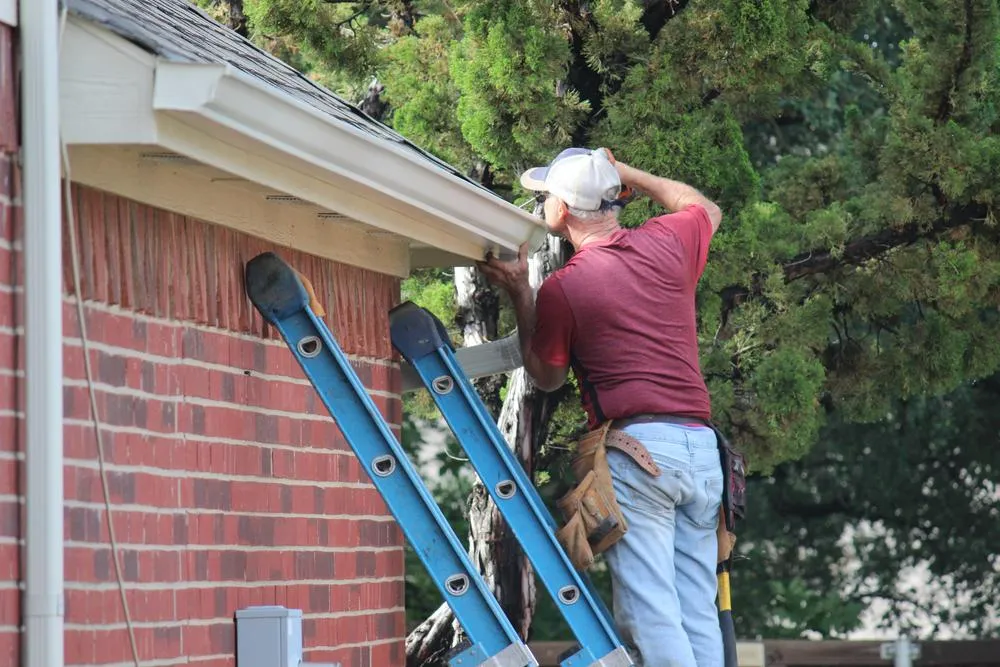
Benefits of Seamless Gutters vs. Traditional Gutters: What’s Best for Your Roof
When it comes to protecting your home from water damage, few features are as essential as a reliable gutter system. Yet homeowners in Western Kentucky often face the same question: should I go with seamless gutters or stick to traditional sectional gutters?
Both systems channel rainwater away from your roof and foundation, but they’re not created equal. In this guide, we’ll break down the differences, benefits, and drawbacks so you can decide which option is best for your Paducah area home.
Understanding the Two Types of Gutters
Before comparing the advantages, let’s define what we mean by seamless versus traditional gutters.
Traditional Sectional Gutters
These gutters are installed in pre-cut sections that are joined together along the roofline. Seams are sealed during installation, and the system is pieced together to fit the house.
Seamless Gutters
Seamless gutters are custom-made on-site from a single piece of material, usually aluminum. Because they are continuous, they have far fewer seams or joints along the run, reducing weak spots where leaks typically form.
Benefits of Seamless Gutters
Seamless gutters have become the gold standard for many homeowners — and for good reason. Here are the key benefits:
Fewer Leaks: With minimal seams, water has fewer chances to escape or leak through.
Longer Lifespan: Reduced joints mean less wear and tear over time, leading to better durability.
Custom Fit: Built on-site to match your roofline perfectly, improving performance and appearance.
Low Maintenance: With fewer seams, there’s less need for sealant upkeep and patching.
Curb Appeal: Seamless gutters create a sleek, uniform look that adds to your home’s exterior.
Drawbacks of Seamless Gutters
While seamless gutters offer many benefits, they aren’t perfect. Here’s what to consider:
Higher Upfront Cost: Because they are custom-made, installation costs are typically higher than sectional gutters.
Professional Installation Required: Unlike sectional gutters that can be DIY-installed, seamless gutters require a professional team with the right equipment.
Repair Challenges: If a section is damaged, the entire piece often needs replacement instead of just a small segment.
Benefits of Traditional Sectional Gutters
Some homeowners still prefer traditional gutters for practical reasons. Their main benefits include:
Lower Initial Cost: Sectional gutters are usually less expensive upfront.
DIY-Friendly: Homeowners with experience can install or repair sections themselves.
Easy Repairs: If one section fails, you can replace only that portion.
Availability: Readily available at most hardware stores in pre-cut lengths.
Drawbacks of Traditional Sectional Gutters
The trade-offs of sectional gutters make them less ideal for long-term performance:
More Leak Points: Every seam is a potential failure point for leaks.
Shorter Lifespan: Frequent sealing and repairs are often required.
High Maintenance: Debris can catch on joints, leading to clogs.
Less Aesthetic Appeal: Visible seams may detract from the appearance of your roofline.
How to Decide: Which Is Best for Your Roof?
When choosing between seamless and traditional gutters, consider these key factors:
Step 1: Evaluate Your Budget
If you want to minimize upfront costs, sectional gutters may seem attractive. But if you value longevity and reduced repairs, seamless gutters may save money over the long run.
Step 2: Consider Your Home’s Design
Custom homes, larger rooflines, or high-value properties often benefit most from seamless gutters because of their tailored fit and visual appeal.
Step 3: Think About Maintenance
Homeowners who don’t want to constantly reseal and check for leaks will prefer seamless gutters. Sectional gutters, on the other hand, may be manageable for those who enjoy DIY upkeep.
Step 4: Look at Local Conditions
In Paducah and surrounding areas, heavy rainfall and falling leaves are common. Seamless gutters handle these conditions more effectively because they reduce clogging and leakage points.
FAQs
Are seamless gutters worth the extra cost?
Yes. While the upfront investment is higher, the reduced maintenance, fewer leaks, and longer lifespan often make seamless gutters more cost-effective over time.
How long do seamless gutters last?
With proper installation and care, seamless aluminum gutters can last 20 to 30 years or more.
Can seamless gutters be installed on any home?
Yes. Because they are custom-made on-site, they can be tailored to fit nearly any roofline.
What’s the biggest downside of sectional gutters?
The seams. Over time, they expand, contract, and weaken, leading to leaks and maintenance issues.
Do seamless gutters require cleaning?
Yes. They still need regular cleaning and inspections, but because they have fewer joints, they tend to stay clearer of debris buildup than sectional gutters.
Conclusion
Both seamless and traditional gutters have their place, but for most Paducah area homes, seamless gutters provide the best balance of performance, durability, and appearance. They require less maintenance, offer fewer leak points, and are custom-fit to your roof.
If you’re considering upgrading your gutter system, scheduling a professional inspection is the best next step. A local expert can measure your home, explain the options, and install a system that will protect your home for decades.